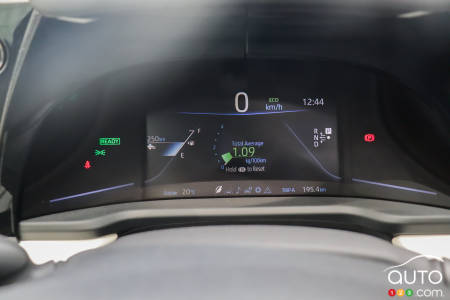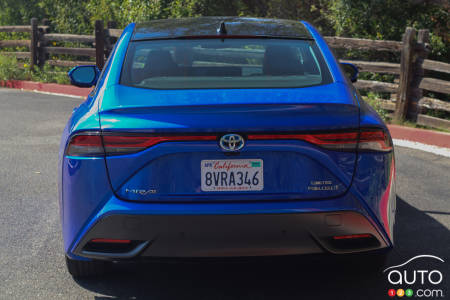• Auto123 reviews the 2022 Toyota Mirai.
• The EV – and yes it is an EV – is powered by hydrogen, and emits only water.
• Unless you’re in B.C. (or a few spots in Quebec and Ontario), there are for the moment no public stations in Canada to refill your Mirai, sadly.
The Toyota Mirai 2.0 comes at an interesting time in the automotive world. While every other major OEM focuses on battery-electric vehicles (BEVs), Toyota is taking a different tack. Even as it scrambles to catch up on the BEV front, it is maintaining its commitment to hydrogen-powered fuel cell electric vehicle (FCEV) technology. To wit, it’s launched a new generation of the Mirai.
This comes as Toyota readies to launch its first EV, though the bZ4X’s recent challenges – as well as those of its Subaru Solterra twin – have been well-documented. The Mirai, on the other hand, is already on its second generation. And it’s looking altogether new, more premium and actually less avant garde that the first model.
Browse cars for sale available near you
The exterior
You can see it right away: the Mirai now shares its basic chassis architecture with the Lexus LS Series, meaning it has a low, wide stance and a somewhat grand touring-like cab rearward design. It gets an all-new front fascia with properly aggressive headlight lenses that look hawk-like and while the rear end is a little softer, it is futuristic…but in a classy way.
Essentially, the Mirai now looks less like a Prius designed on acid, more like the Lexus model on which it’s based. Either way, it drew far more attention than I thought it would during my week with it, although it wasn’t just the styling that seemed to turn the trick, as we’ll see in just a moment.
The interior
Inside, it isn’t quite so ultra-modern, in part because on that 12.3-inch central display (not small, I admit) you find Toyota’s older infotainment interface, which has since been replaced elsewhere and not a moment too soon. The graphics aren’t that sharp, the colour palette is muted and it just isn’t all that fast or intuitive. At least it functions as a touchscreen display, saving users from having to rely on a joystick or – shudder – a touchpad.
You do, however, get a wireless charge pad, Apple CarPlay and Android Auto and standard 14-speaker JBL audio on both the XLE and the Limited, the version I drove. You also get heated front seats (upgraded to heated and cooled on the Limited, which also gets heated rear seats), 8-way power driver’s seat and synthetic leather seating as well as a heated steering wheel. It’s fully featured and this side of slightly more adjustable seats, it’s hard to expect much more at the sub-$55,000 price level.
Unfortunately, upgrading to the Limited will take you over $76,000 in Canada. For that you do get niceties like a digital rear-view mirror, heads-up display and 20-inch wheels instead to the 19-inch wheels of the XLE, but that seems like a big price jump considering there are no mechanical differences between the two. Still, it’s a lot less than it takes to move into the Lexus LS. Or something like the Genesis G80 Electric.
The infotainment display is one thing, but the other gripe I have with the Mirai is that big as it is, it’s just not that big inside. Even though they’ve rearranged the alignment of the hydrogen storage tanks from previous to carve out more space, this version gets a third tank, and there is no pass-through door to the trunk so you can forget about hauling longer items.
The back seats are snug for such a large vehicle, and while the front seats are comfortable and spacious enough, you do have to contend with an enormous centre console. Yes, they’ve put that space to good use with the charge pad, two cupholders, a tiny little dongle for a shift lever (evoking that found in the Prius) and a wide (if not that deep) storage bin, but you will feel… ensconced.
This is one of the main issues when it comes to hydrogen power: you need to find a place to store all that hydrogen and you can only compress it so far without it becoming unstable.
Take note that Toyota has taken steps to further increase the safety of the new Mirai’s fuel system by developing thinner but stronger hydrogen fuel tanks, crafted from carbon-fibre reinforced plastic.
The powertrain
Ahh, the powertrain. Know that aside from the car’s styling, it’s those “fuel cell” badges on the rocker panels and trunk that garnered the questions during my time with the Mirai. I had people in everything from Honda Civics to Cadillac Escalades – in the same mall parking lot, actually -- corner me about what it meant.
So in a nutshell, what we have here is a hydrogen fuel system that feed fuel cell stacks, which in turn power an EV motor, which in turn powers the rear wheels through a 1-speed direct-drive transmission to the tune of 182 hp and 221 lb-ft of torque.

On the road
On paper the acceleration is modest, taking about 10 seconds to get from 0-100 km/h, but here’s the thing: the Mirai drives like an EV – well, it is an EV – meaning quick throttle response with no delay to let the transmission and motors get on the same page. So it feels much faster than the numbers suggest and most of all, it feels smoother.
The Mirai is a big, heavy car at almost 2,000 kg, but the suspension has been tuned just so for both a great ride and the ability to move through corners and from stops without feeling too much like a porker, helped along by the RWD powertrain. It will even give you some fake engine sounds if you want it but these sound kind of cheap, so I switched them off.
Of course, in this game, a lot of that is secondary to the big question, and that’s just how far your heavy-but-light-feeling sedan can take you on a full tank.
Toyota claims 647 km on a full tank of hydrogen, but I never saw more than 450 on a fill, in pretty mild temperatures. Of course, keep in mind that I was not the first driver of this vehicle and there is a memory so like all EVs, that’s an estimate based on prior learning. After my ranged drive, however, I had driven 10 km less range than predicted, which is not a huge drop. But still, it’s a shame that theoretical max never seemed even close to possible.
B.C. only
At least I was able to earn that back quickly, however. Filling up with hydrogen takes about as long as it does to fill a tank of gas, and it’s all done in a similar fashion. In Vancouver, where I live, you pull up to one of the handful of gas stations that offer hydrogen fill-ups, just as you would with an ICE car. You swipe your card, punch in your email for a receipt and plug in. You don’t even have to keep a hand on the nozzle; it locks itself in, and that’s that. Half a tank cost me about $33 and at the time, that was around $10 less than it would have cost me to fill half a tank on a gas car of similar size to the Mirai.
Which, I guess, is really where hydrogen power comes into its own. Many are asking “why not just go full EV?” and that’s a fair point, but the amount of time saved over a BEV when it comes to filling – even with home charging – will be an attraction to some. As will the fact that the only thing produced while driving is…water.
Having to deal with a limited fill network is another thing, however, and that continues to be a big stumbling block for this segment. Outside of B.C., where the network is small but at least existent, there’s just one station in Quebec, and a handful in Ontario. The infrastructure is set to grown, however, and if ever hydrogen does catch on, Toyota’s got quite a hat in the ring with the Mirai.

We like
Styling
Great ride
We like less
Cramped interior
Aged infotainment
The competition
None, and all BEVs



